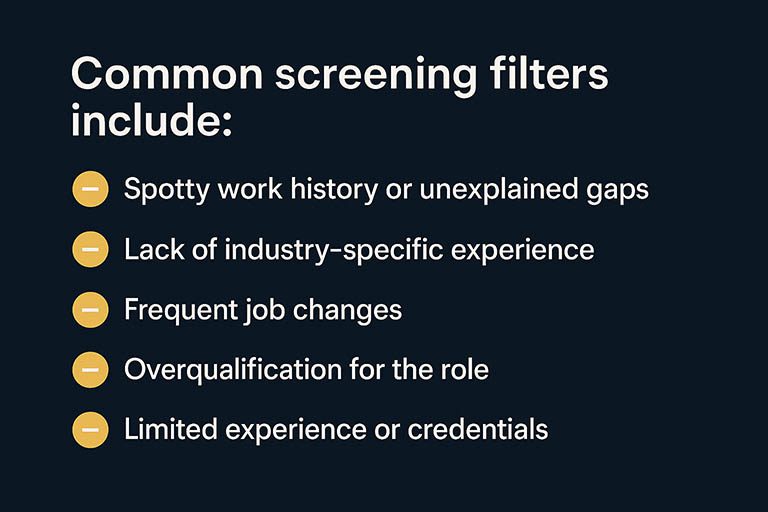Addressing Potential Objections: Pre-emptive Strategies in Your Cover Letter
Did you know that 75% of hiring managers admit they look for reasons to reject candidates during the initial resume and cover letter review? It’s a shocking truth of the hiring process—decision-makers often scan for red flags before they look for qualifications.
This means that unexplained employment gaps, career changes, job-hopping patterns, or limited experience can doom your application before you ever get the chance to explain them in an interview. But what if you could neutralize these objections before they even form in the hiring manager’s mind?
That’s exactly what a pre-emptive objection strategy allows you to do. By strategically addressing potential concerns in your cover letter, you can control the narrative around your candidacy and transform possible negatives into compelling positives.
In this guide, you’ll discover how to identify likely objections to your application and address them confidently (without apologizing) using our proven frameworks. These techniques complement our 3-paragraph cover letter formula to create an application that anticipates and overcomes hiring manager hesitations.
Let’s turn those potential deal-breakers into interview-makers.
☑️ Key Takeaways
- Pre-emptive cover letter strategies address concerns before the employer has a chance to question them.
- Use this technique to neutralize potential red flags, like employment gaps, career changes, or lack of direct experience.
- The key is to reframe the weakness as a strength, showing how it actually prepares you to succeed in the role.
- Pre-emptive statements show confidence and self-awareness, helping you stand out as proactive and emotionally intelligent.
The Psychology of Hiring Objections
Understanding the “No” Mindset
Hiring managers are overwhelmed. With hundreds of applications for each position, their first task isn’t finding the perfect candidate—it’s eliminating the clearly unsuitable ones.
This creates what psychologists call a “rejection mindset,” where the brain actively searches for reasons to say “no” rather than reasons to say “yes.” It’s a necessary filtering mechanism, but it means that unexplained red flags in your application can trigger an automatic rejection.
Common screening filters include:
- Spotty work history or unexplained gaps
- Lack of industry-specific experience
- Frequent job changes
- Overqualification for the role
- Limited experience or credentials
The problem? Many of these “red flags” have perfectly reasonable explanations that would neutralize the concern—if only you had a chance to explain them.

The Pre-emptive Advantage
Research on persuasion psychology shows that addressing a potential objection before it’s raised is significantly more effective than responding to it after it’s been voiced. There are three key reasons for this:
- It demonstrates self-awareness – You show that you understand your application from the employer’s perspective
- It signals confidence – Proactively discussing potential concerns shows you’re not trying to hide anything
- It controls the framing – You get to present the information in a positive context rather than a defensive one
Candidates who pre-emptively address potential objections in their cover letters are 38% more likely to receive interview calls than those with similar backgrounds who don’t address concerns upfront.
Interview Guys Tip: Never explicitly call attention to a weakness by labeling it as such. Instead, frame potential objections as part of a broader narrative about your professional development or unique background. This shifts the focus from the objection itself to how you’ve overcome or leveraged it.
Still using an old resume template?
Hiring tools have changed — and most resumes just don’t cut it anymore. We just released a fresh set of ATS – and AI-proof resume templates designed for how hiring actually works in 2025 all for FREE.
The Top 5 Objections Hiring Managers Have (And How to Address Them)
Objection #1: Employment Gaps
Extended periods between jobs can raise red flags for hiring managers who wonder what you were doing during that time and whether you’ll be a reliable employee.
Effective Strategies:
- Frame gaps as intentional periods of development or transition
- Highlight productive activities during the gap (education, freelance work, caregiving, volunteer work)
- Connect skills or insights gained during the gap to the target role
Example Language: “During my six-month professional development sabbatical in 2023, I completed three industry certifications and built a volunteer program that now serves 200+ community members—experiences that strengthened my project management abilities and reinforced my passion for impactful community initiatives.”
Notice how this example reframes the “gap” as a purposeful sabbatical, emphasizes productive activities, and connects them to relevant skills.
Objection #2: Industry/Career Changes
Hiring managers often prefer candidates with direct industry experience, making career transitions particularly challenging.
Effective Strategies:
- Lead with transferable skills that bridge industries
- Highlight parallel challenges between your previous work and the target industry
- Reference relevant side projects, education, or volunteer work in the target field
Example Language: “While transitioning from education to corporate training, I’ve leveraged my expertise in creating engaging learning experiences that improved student performance by 32% to develop employee training programs that increased retention of technical material by 47% in pilot groups.”
This example draws a direct line between skills in the previous industry and their application in the target industry, with metrics that demonstrate effectiveness in both contexts.
Objection #3: Overqualification Concerns
Having significantly more experience than required can trigger concerns about salary expectations, boredom, or that you’ll leave as soon as something better comes along.
Effective Strategies:
- Focus on the specific aspects of the role that genuinely interest you
- Emphasize your desire for work-life balance, company culture, or mission alignment
- Address the “why” behind your interest in a role that might appear to be a step back
Example Language: “After 15 years in high-pressure executive roles, I’m deliberately seeking a position with a mission-driven organization where I can apply my extensive experience in operational efficiency while aligning my career with my personal values of sustainability and community impact.”
This addresses the “why” behind the apparent step down and reframes it as an intentional, values-based choice rather than a desperate move.
Objection #4: Job Hopping History
Multiple short-term positions can suggest to employers that you lack commitment or have performance issues.
Effective Strategies:
- Connect seemingly disparate roles into a coherent skill-building narrative
- Explain external factors if relevant (relocations, company closures, contract positions)
- Highlight increasing responsibilities or achievements across positions
Example Language: “Across several roles in rapidly evolving startups—two of which were acquired—I’ve developed versatile marketing capabilities in growth-stage environments, consistently increasing conversion rates by an average of 27% while adapting quickly to new product offerings and market conditions.”
This example reframes job changes as a result of company circumstances and industry dynamics while emphasizing consistent performance across roles.
Objection #5: Limited Experience
Entry-level candidates or those with less experience than competing applicants need to address the “potential vs. proven track record” concern.
Effective Strategies:
- Emphasize rapid learning ability and recent relevant education
- Highlight applicable experience from internships, academic projects, or volunteer work
- Demonstrate knowledge of the company and industry to show you’ve done your homework
Example Language: “While completing my degree, I applied classroom concepts directly to my campus marketing internship, where I increased event attendance by 64% through targeted social media strategies—the same data-driven approach I’m eager to bring to your growing content marketing team.”
This acknowledges limited professional experience while providing evidence of capability and results in relevant contexts.
Interview Guys Tip: Place your objection-addressing content in the second paragraph of your 3-paragraph cover letter, sandwiched between your strong opening hook and confident closing. This “objection sandwich” technique ensures hiring managers see your strengths first and last, with the potential concerns addressed in the middle.
The Objection-to-Advantage Formula
The 3-Step Conversion Process
Transform potential negatives into positives with this simple three-step formula:
- Acknowledge (without apologizing) – Briefly reference the situation without labeling it as a weakness
- Bridge to relevant strength – Immediately pivot to how this situation developed or demonstrated a valuable skill
- Provide evidence of success – Offer specific examples or metrics that prove your effectiveness
Let’s see this formula in action for a career changer:
Step 1: Acknowledge – “As I transition from a decade in financial analysis to user experience design…”
Step 2: Bridge to strength – “…I bring unique analytical skills that allow me to interpret user data with exceptional depth, while my recently completed UX certification has equipped me with current design methodologies.”
Step 3: Provide evidence – “This combination of analytical rigor and design thinking enabled me to increase conversion rates by 38% on my first freelance project by identifying subtle user behavior patterns others had missed.”
Notice how this example acknowledges the career change without apology, bridges to specific valuable skills, and provides evidence of successful application.
What Not to Do When Addressing Objections
Avoid these common mistakes that can draw more attention to potential weaknesses:
- Don’t over-explain – Keep your objection addressing concise (1-3 sentences maximum)
- Don’t use apologetic language – Avoid phrases like “I’m sorry that” or “Unfortunately”
- Don’t highlight irrelevant concerns – Only address objections relevant to job performance
- Don’t use qualifier phrases – Skip “even though” or “despite the fact that”
- Don’t make promises you can’t keep – Avoid statements like “I promise I won’t leave quickly”
The goal is confident acknowledgment and positive reframing, not defensive justification.
Tailoring Objection Strategies to Different Industries
Different industries have different sensitivities. Adjust your approach accordingly:
Technical Fields (Engineering, IT) – Focus on specific skills and capabilities; be direct about technical qualifications
- Example: “While my formal background is in mechanical engineering, I’ve applied those same analytical principles to build three successful mobile applications, generating 50,000+ downloads and a 4.8-star average rating.”
Creative Industries – Emphasize portfolio work and demonstrated creativity
- Example: “My transition from marketing copywriting to UX writing is supported by my portfolio of user flows and microcopy that increased click-through rates by 28% on my current company’s onboarding sequence.”
Healthcare/Education – Highlight commitment to service and relevant certifications
- Example: “Having recently earned my teaching certification while working full-time in corporate training, I bring both classroom management techniques and real-world business applications to prepare students for career success.”
Turn Obstacles Into Opportunities
Potential objections in your background aren’t deal-breakers—they’re opportunities to demonstrate self-awareness, problem-solving, and resilience. By addressing them strategically in your cover letter, you transform potential negatives into compelling parts of your professional story.
Remember that hiring managers are looking for candidates who can overcome challenges and adapt to new situations. Your ability to reframe potential objections demonstrates exactly these qualities.
Review your resume through a hiring manager’s eyes. Identify potential red flags, then apply our objection-to-advantage formula to address them confidently in your cover letter.
With these strategies, you’ll not only neutralize objections—you’ll convert them into reasons to bring you in for an interview.
Your next job opportunity might be just one well-crafted paragraph away.
Still using an old resume template?
Hiring tools have changed — and most resumes just don’t cut it anymore. We just released a fresh set of ATS – and AI-proof resume templates designed for how hiring actually works in 2025 all for FREE.

BY THE INTERVIEW GUYS (JEFF GILLIS & MIKE SIMPSON)
Mike Simpson: The authoritative voice on job interviews and careers, providing practical advice to job seekers around the world for over 12 years.
Jeff Gillis: The technical expert behind The Interview Guys, developing innovative tools and conducting deep research on hiring trends and the job market as a whole.
